GMB + PCC = Magic, The Kirsty Grosart Interview
By Adrienne Harvey, SrPCC, RKC-II, CK-FMS
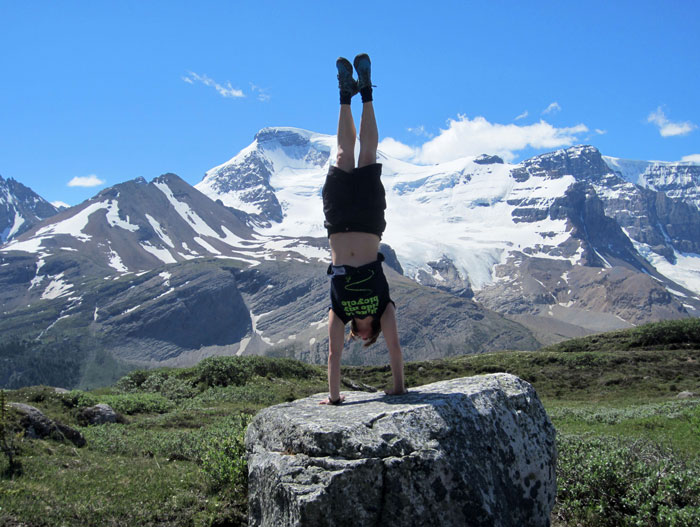
Dragon Door: How long have you been involved in gymnastics, athletics, and fitness?
Kirsty Grosart: As a kid I did competitive gymnastics from age six to nineteen, then took a break from it for most of my twenties. It wasn't until I bought my house and built a gym in the garage that I started doing bodyweight training again. It was mostly because I didn’t have much in the garage—I built a pull-up bar, had some mats, a set of p-bars and some
rings. So, just over five years ago I started doing bodyweight training and hand balancing and got obsessed with it again.
Dragon Door: Were you also coaching at this point?
Kirsty Grosart: When I stopped competing in gymnastics at age 19, I coached high level competitive gymnastics for the next 3-4 years before I moved away to go to university. Then, about five years ago—around the same time I got back into bodyweight training—I started coaching kids in recreational gymnastics which was a lot of fun. Also around the same time I started coaching a gymnastics class at a CrossFit gym. I still have a regular job writing software.
Dragon Door: What inspired you to turn your garage into your gym?
Kirsty Grosart: When we bought the house, the previous owner was using it as a yoga studio and taught classes in there. It wasn’t very garage-like, but it was hideous—green carpet on the floor with orange and purple floaty fabrics everywhere! But it inspired us to put up something really cool in there. So, we built pull-up bars, and I have a pole in there too. When we first moved in, I was doing a lot of
kettlebell stuff as well which is how I found you online and started using all the stuff on your website, the workouts, videos, and listening to your podcasts.
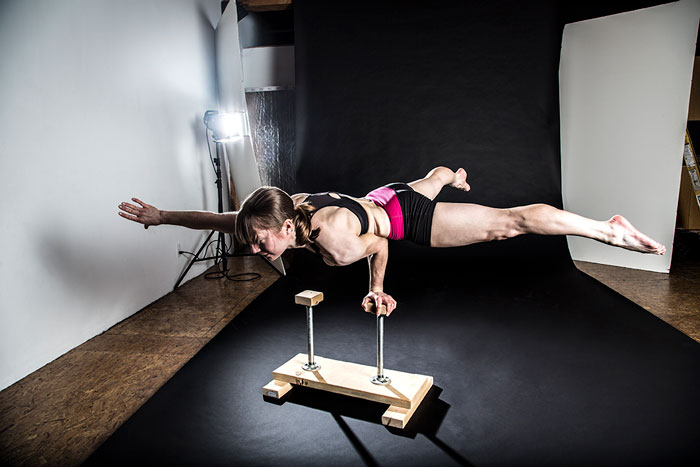
Dragon Door: Wow, thanks! I had no idea! How did you get involved with GMB?
Kirsty Grosart: When I first started teaching adult gymnastics classes at the CrossFit gym I was teaching it the way I had learned—competitive gymnastics. With competitive gymnastics you start in specific positions. Everything is very strict and form is exact. But, there was no reason CrossFitters had to start their handstands with their arms up and their toes pointed. The more I taught, the more I realized that some of what I had been teaching them was not necessary.
Adults have a lot of different roadblocks compared to the kids—adults have many more mobility restrictions. Often, the biggest thing is fear. With a lot of movements like handstands, the adults were scared of falling, so I started changing the way I coached. I also looked online for information about teaching gymnastics to adults who don’t have a gymnastics background. That's how I found GMB. I emailed Ryan, and two days later we were on Skype and the rest is history.
Dragon Door: That’s such an important point you’ve made about training for competitive gymnastics vs. fitness movements that cross over into gymnastics. How do you explain the difference to the people you train?
Kirsty Grosart: The main way we explain it that in gymnastics there are certain things you must do in order to get maximum marks. You always need to have straight legs, your legs together, and your toes pointed. Landings don’t necessarily have to be safe landings—and you will see many gymnasts land in positions that aren’t optimal for their knees, but they won’t have any points deducted because they have their feet in a particular position and they don’t move.
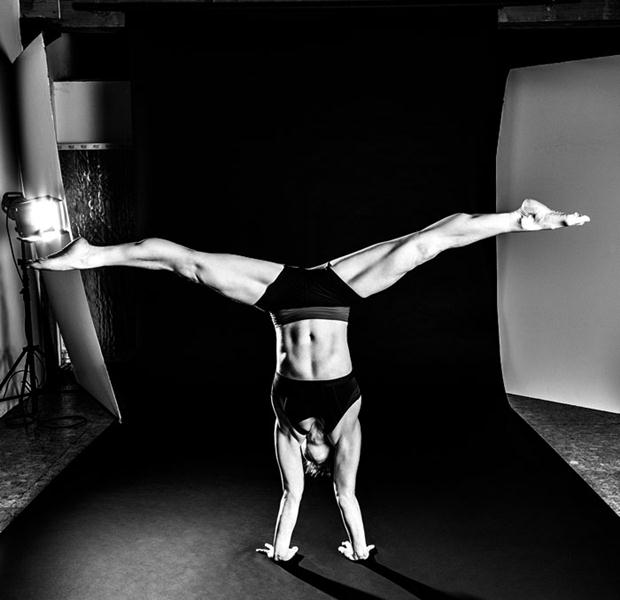
When teaching regular adults, I explain that what they learn from these skills will help them with everything else. But, when we land, there's no reason for us to land in a way that would only help our score with a gymnastics routine. We want to land in the safest way that's also the most applicable to landing in real life situations. Our training is more about getting stronger in ways that will help us do what we want to do in life.
Dragon Door: What brought you to the PCC?
Kirsty Grosart: Ever since seeing the very first
PCC Workshop, I've wanted to go! I've been following you and Al for years. Seeing pictures of Al doing flags anywhere and everywhere made me want to learn to do a flag. Since I come at it with gymnastics experience, I think of everything in a particular way. It’s very interesting to get insight from people with different training backgrounds.
I really loved that there were seven instructors. From personal experience I know that it's very challenging to teach with even one other person—you will have certain things you want to say, and so do the other instructors. It can be easy to overwhelm the participants, but I was impressed with how well all the instructors worked together. Of course
Al and Danny know each other very well, but everyone also had their own input, and it didn’t feel overwhelming. It was well coordinated, and I was very impressed because I know how difficult it can be to teach with so many other instructors.
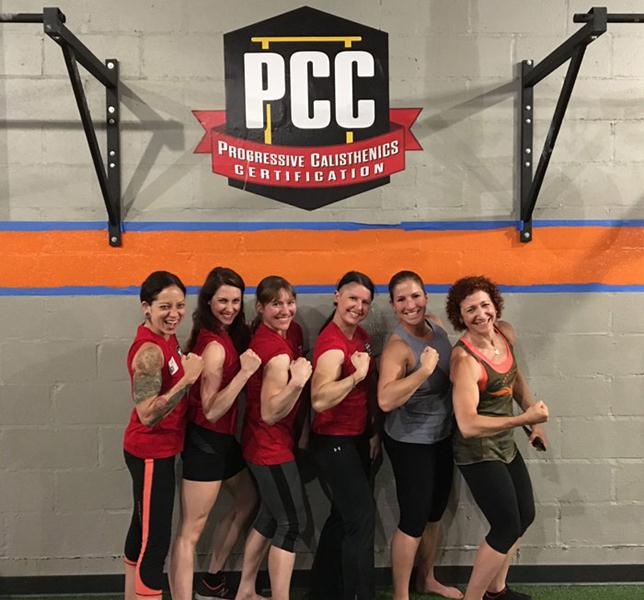
It was also really great that the instructors all had different backgrounds. You have your kettlebell background, Beth has a dance background, and Grace has a yoga background. Each
instructor brought something cool and different when explaining certain things to us. It was a very fun and instructional workshop!
Dragon Door: And you did a really impressive flag at the PCC! That was great to see, how long have you been working on it?
Kirsty Grosart: I think I’ve been trying to learn the flag for about three or four years. I actually started with the
Convict Conditioning Vol. 2 flag progressions and followed through them all. Then last year, one of the my biggest improvements happened when I really started working on my front lever. When I went back to my flag again after training my front lever, the increase in my core strength from the front lever really helped my flag.
Dragon Door: That makes a lot of sense! The flag is such a long journey.
Kirsty Grosart: And every little bit takes time, every variation like bent legs, to getting one leg straight—and then getting the other leg out a little more. Just lowering by one degree is a challenge. All these steps take so much time, but that's the really cool thing about bodyweight training—it’s not about lifting a new weight, you are actually able to do a new variation or a new skill every step of the way.
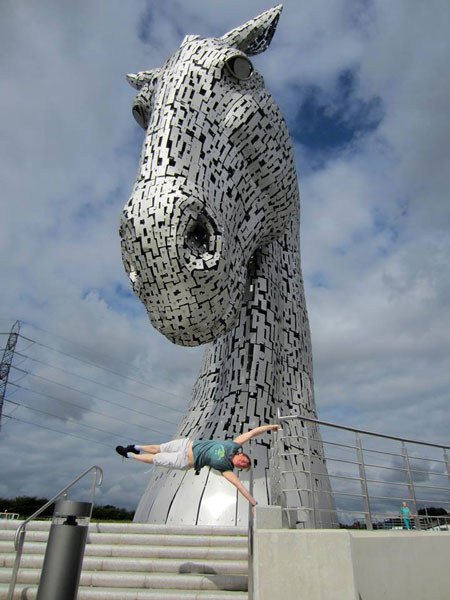
Dragon Door: What was your favorite section or sections at the PCC?
Kirsty Grosart: I enjoyed the flags because of the environment and atmosphere during that section. With pull ups and push ups, even though there are variations people hadn't tried before, most everyone has done push ups and pull ups. But I don’t think many people have ever really attempted the flag. So trying it or getting it for the first time is such a cool feeling, and it was great to see everyone have that experience.
And I really liked the
abs section because there was a lot of cool stuff that I had never actually done before. Even though I’ve been doing hollow body variations since I was six, I learned versions I had never tried. The hollow body variation with with your head on the floor seems obvious now, but it felt a lot harder for me, especially since I’d never tried it before the PCC. It was really interesting to find a new way to make a skill I’ve done for a long time more challenging.
Dragon Door: What are you working towards right now in your own training?
Kirsty Grosart: I’ve started working on the front lever again, and that's another one where the progress is slow but it's fun. For the longest time I didn’t know if I was even capable of doing it. For a long time, I'd never seen a woman do a full front lever, then I saw a couple of climbers do it and then this girl from Sweden, Madeleine Leander. She is amazing, and has probably has her full front lever by now or is really close and can hold it for a few seconds. So, after I saw that, I said yes, I can do this. So I am really working hard the front lever and all my handstand stuff.
Dragon Door: We were so glad that you demonstrated your awesome handstands at the PCC!
Kirsty Grosart: There’s something about doing handstands and being upside down with that kind of control—it's a lot of fun.
Dragon Door: Earlier you mentioned that many adults are afraid of going upside down. What are your favorite cues or lead up drills to help your students overcome that fear?
Kirsty Grosart: The main thing is to keep people feeling safe. So, until they have the strength in their arms, keep them against the wall, or with their feet on a block until they have that strength. Then, when they are ready to move away from the wall, teach them how to fall and bail out of a handstand. Obviously no one wants to land flat on their back, so I teach how to land and cartwheel out of a handstand. Once they are confident that they can get out of the handstand safely if they go over, then a lot of the fear goes away. The disorientation of being upside down is also huge for people when they are first starting out.
So, if someone is still in a disoriented phase, I have them just stay with the wall. Locomotions like bear walks with the hands and feet on the floor with the hips high in the air can also help people get used to being a little bit upside down at first.
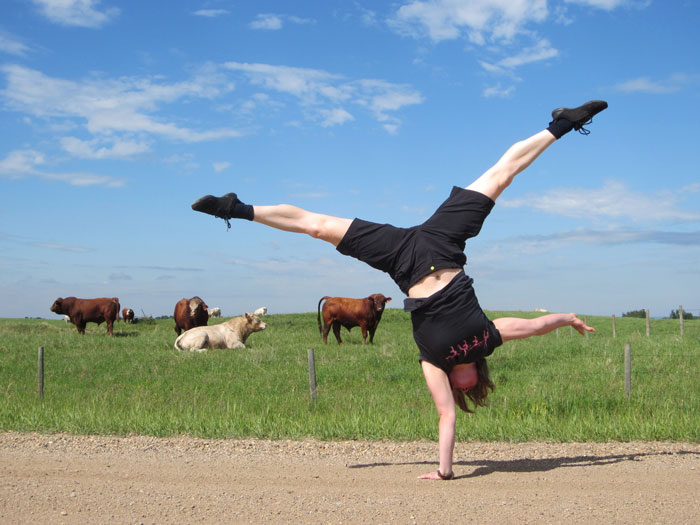
Dragon Door: There are many mainstream ideas about what women "can’t" do in their training. Since you and I know better, what are some helpful ways you’ve found for helping our students conquer some of the most challenging calisthenics moves?
Kirsty Grosart: In many cases, it seems to be about
mindset. Many women approach bodyweight training with the idea that they can’t do
pull-ups or some other move because they’re a woman, or because they aren’t strong enough yet, or they think they need to lose weight first. So, I show them that they are capable of doing it by regressing the movement down to a level where they feel comfortable. This shows them that they have the strength to do that variation, and that the next variation will require just a little more strength. Once I break it down, and show them how to go from one step to the next, they learn that they can build the strength to go to the next level. It can really help give them confidence.
Since I grew up doing gymnastics, when I see a new skill (except for that front lever) I immediately know that I can do it! I have that ex-gymnast arrogance that makes me think I can do everything! But part of it is from experiencing the process of learning so many skills step by step. I know that by practicing progressions, I will get stronger or gain the necessary skill to eventually do the move. After doing this so many times growing up, I just think, "I can't do it right now, but if I do xyz then I will be able to build up everything I need for that skill." I teach this idea to the new people who come to my classes or who I start coaching.
Dragon Door: That's such an important lesson because it spills over into every aspect of life. Other than the front lever we talked about earlier, what is the most challenging move from the PCC for you at the moment?
Kirsty Grosart: I find the bar muscle-up to be so challenging. The first time I managed to do a
bar muscle-up was at the PCC! I had been working on the bar muscle-up last year and overtraining it a little because I felt like I should be able to do it. I ended up hurting my shoulder while training it. So, when I tried it at the PCC it was the fist time I’d tried it again since then. Thankfully my shoulder is much stronger now, but I still find the bar muscle-up to be super challenging.
Back